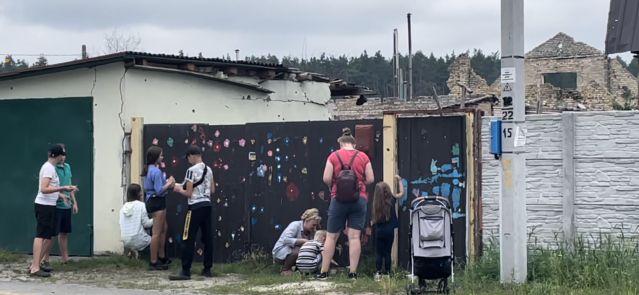Trauma
Using Creative Arts Therapies During War Times
An interview with an expressive arts specialist regarding his work in Ukraine.
Posted September 13, 2023 Reviewed by Devon Frye
Key points
- Expressive therapy initiatives assist trauma survivors with means for self-expression, unity, and empowerment.
- Creative arts can be introduced in crisis intervention work to reduce PTSD symptoms and foster resilience.
- One creative arts specialist is on a mission to bring the healing arts to those facing severe adversity.
- In this interview, we learn about front-line efforts to provide Ukrainians with psychosocial support.

“Today we are painting our future. Our children are not afraid of the Russian bullets at this moment. (They are) changing bullet holes into art,” a Ukrainian woman said.
Benjamin Swatez is an international muralist, expressive arts therapist, and co-founder of The Goodness Tour, a non-profit organization offering psychosocial support through creative and expressive arts to communities enduring war, natural disasters, and humanitarian violations. He drove into the war-torn areas of Ukraine with his paint and brushes.
“Why did I choose to enter a war zone?" he asked. "Because every human deserves the basic right to live, play, and express themselves.”
Most relief agencies are called in during crises to provide water, food, and shelter. The psychosocial support needs are often secondary if offered at all. Yet while living in war zones, the trauma reactions are constant, chronic, and all-consuming. War survivors live in a hyper-aroused state of fear and panic, not knowing when bombs or enemy raids will land in their villages.

During World War I, the term used to describe the “signature injury of war” was “shell-shocked.” This syndrome describes a soldier’s reaction to the intensity of war, resulting in panic, helplessness, and difficulties with reasoning, sleep, and eating. This was a precursor to the PTSD that followed a soldier’s return home.
I interviewed Benjamin Swatez about his experiences while working with “shell-shocked” survivors in Ukraine. Mr. Swatez’s doctoral research for the European Graduate School of Expressive Arts in Switzerland is focused on the effects of implementing an expressive arts therapy curriculum in first responder settings. His courage and commitment to sharing the creative arts within war and disaster zones are fueled by his belief in the healing power of artistic expression.
CL: What is your background, and how did you come into this work?
BS: We all have a personal relationship with trauma in one form or another. Art has been an empowering vehicle that continually inspires me to reframe traumatic events that would have otherwise been psychologically debilitating. While enduring my traumatic times of surviving violence and living on the streets, art was my healer.
My international career includes exhibiting peace-building art in museums on four continents and painting large-scale murals with struggling communities in more than forty countries. I enter the front lines of a crisis and initiate art as a connecting and empowering medium. My aim is to have psychosocial support acknowledged and endorsed as an essential need for first-response teams worldwide.
CL: How do creative arts help in a crisis?
BS: Creativity is within us all. It can be oppressed by severe trauma but never extinguished. It is an honor to assist individuals to reawaken their imagination in the face of adversity. I have witnessed how community art projects help build empathy, resilience, and open dialogue.
My work is not a form of escapism. I introduce tools to temporarily step outside of the high-stress psychological condition. In doing so, some villagers could bypass the fight, flight, or freeze responses. Afterward, they were able to reframe their experience with a new outlook toward solutions.
Each day, I witnessed hope expand through creativity. A local artist painted a butterfly on a rusted Russian tank without prompting. I am always struck by how we, as humans, intuitively know how artistic expression can help alchemize our pain. Sometimes, we need the invitation and encouragement.
CL: How is your work received by those in crisis?
BS: With eight gallons of paint, I arrived at 3:50 a.m. in the village of Moshchun on the outskirts of Kyiv, where over 70 percent of the structures were leveled to the ground. I had to carefully avoid hundreds of landmines surrounding the town. Those who did not evacuate prior to the first wave of attacks experienced the unthinkable. I met one mother who watched her son bombed as he was trying to rescue others.
I slept a few hours each night in a desecrated community building while engaging and creating with those remaining. Living with the people, among the rubble established a deep, essential, and enduring trust.
When I first arrived, I saw many glassed-over eyes and frozen emotional states. Within a few days, I saw eyes that emitted inspiration and resilience, even while bomb sirens were blaring. That is the power of creative arts therapy.
One day, I met a 10-year-old girl who had, on her own accord, painted flower petals around bullet holes on a metal fence. “I’m fixing the fence,” she told her parents. We invited all children to join this transformative mission in the city center.

For a three-story community mural, the people asked me to help them paint a stork. “Why a stork?” I asked.
“Because the stork is our symbol of resilience. The stork overcomes all obstacles to always find its way home, and we pray our loved ones find their way home.”
In Lviv, I conducted daily empowering art workshops. We used debris and organic materials to create sculptures; we shared stories, sang, and painted community murals. For these compositions, my approach is not to impose premeditated symbolism. Instead, I invite the community to choose the images and messages relevant to their culture and experiences.
“I am so happy that I’m going to cry. This is the first time I have creatively expressed my voice since the war started,” a young Ukrainian woman said.
Conclusion
The stork mural was broadcast on the official Ukrainian military telegram and spread across the country as a beacon of hope.

Mr. Swatez expressed his gratitude to the courageous Ukrainians and all those who bravely offer psychosocial support services to those in need. He is planning to return to Ukraine and continue this healing work.




